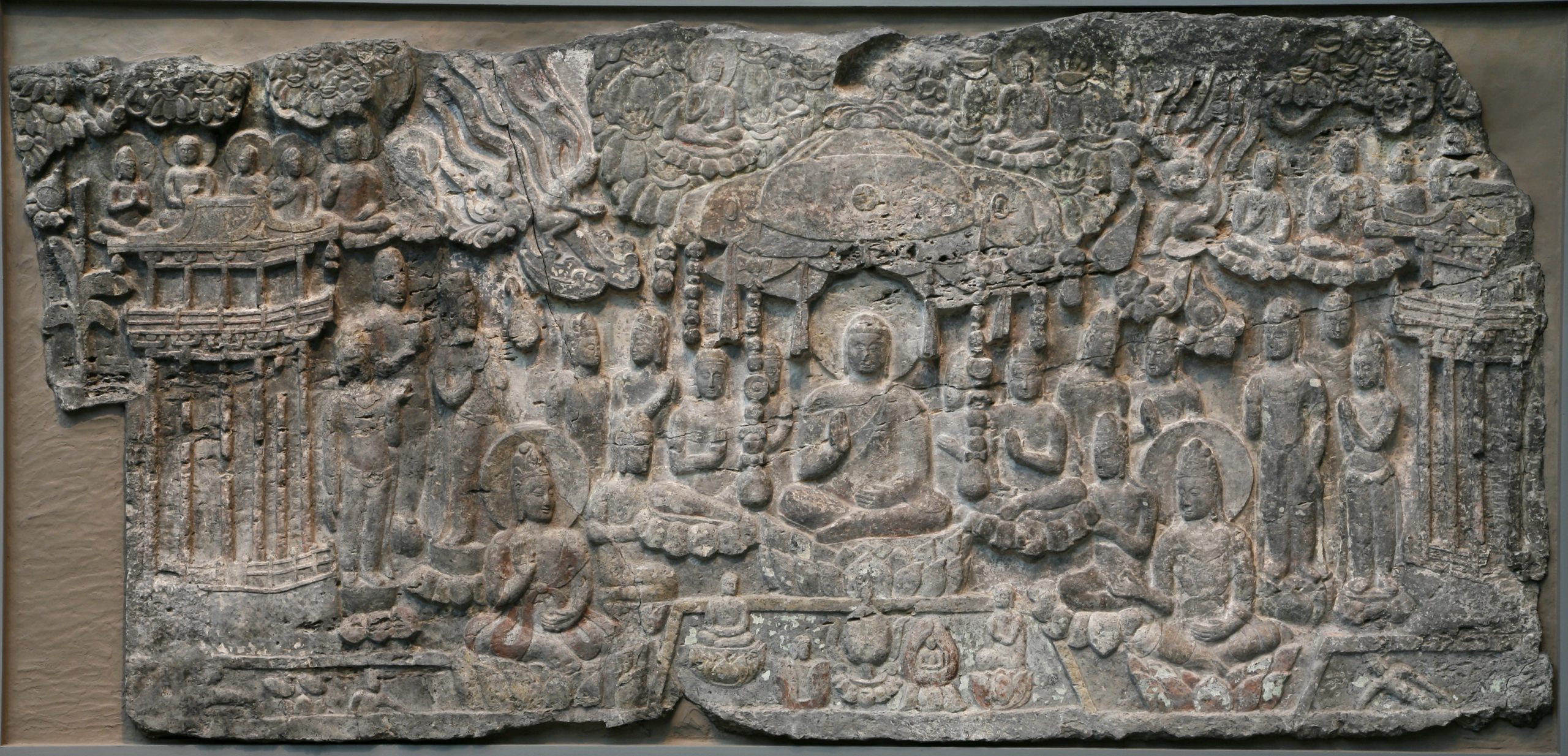This large reliefthree-dimensional forms that protrude from a flat surface. is almost eleven feet long. At the center, a Buddha(bood-huh) literally, “Awakened One”; a being who has awakened to the true reality of existence and is thereby liberated from the cycle of birth, death, and rebirth. A Buddha teaches others the path to Enlightenment. sits under a canopy decorated with strings of large jewels. He raises his right hand to make a teaching or preaching gesture. Seated deva(day-vuh) literally, “divinity,” “heavenly being”; the most pleasure-filled among five rebirth destinies. Rebirth as a deva is granted for good deeds performed during the previous lifetime. crowd around him. Above the canopy, more Buddhas and bodhisattvas(bo-dee-saht-vah) enlightened beings who choose not to proceed to Nirvana but instead remains on earth to guide others in their paths toward enlightenment. sit on lotus and are distinguished by the halos around their heads. Other flying divinities and musical instruments float in the sky. One tall lavish building appears at each side of the relief. A rectangular pond, flanked by the bodhisattvas Avalokiteshvara(ah-vuh-low-kee-taysh-vuh-ra) literally, “The Lord who Looks Down [from on High]”; the widely worshipped bodhisattva of compassion who protects and saves all beings. and Mahasthamaprapta(mah-hah-stah-mah-prahp-tah) literally, “One who Has Attainted Great Power”; a bodhisattva who represents wisdom. He is usually depicted with Buddha Amitabha and bodhisattva Avalokiteshvara. His crown is often decorated with a small water vessel., lies in front of the central Buddha. It is the focus of attention of the Buddha and the two principal bodhisattvas. Inside the pond, small childlike figures sit on lotus blossoms or are enclosed inside the flowers. These represent reborn souls, some lotus blossoms are still tightly closed and others are in full bloom.
The Buddha(bood-huh) literally, “Awakened One”; a being who has awakened to the true reality of existence and is thereby liberated from the cycle of birth, death, and rebirth. A Buddha teaches others the path to Enlightenment. is Amitabha(ah-me-tah-bah) literally, “Infinite Light”; the Buddha of the Western Paradise. Widely revered in Mahayana Buddhist traditions, Amitabha enables his followers to be born into his paradise and attain Buddhahood in one lifetime., the Buddha of Infinite Light. He resides in his heavenly realm called the Western Paradise, or Pure Landalso called Western Paradise, or in Sanskrit as Sukhavati; one of the auspicious places in which to be reborn.. Devotees believe that absolute faith in Amitabha empowers a person to be reborn in his paradise. According to the scriptures, the Western Paradise is a land of bliss. People there enjoy peace and plenty. Beautiful music sounds from the sky. Trees grow precious jewels. The reliefthree-dimensional forms that protrude from a flat surface. depicts Amitabha welcoming newly reborn souls who emerge from lotus blossoms. It is believed to be the earliest known illustration of the Western Paradise in Chinese art.
The reliefthree-dimensional forms that protrude from a flat surface. comes from the wall of a cave at Xiangtangshan(shee-ahng tahng shahn), literally “Mountain of Echoing Halls,” in Northern China. The Buddhist cave temples of Xiangtangshan are a group of worship halls or shrines carved into the mountains during the sixth century. Created with the financial support of the royal family and officials, the caves represent the power and prestige of the throne and the popularity of Buddhist belief at the time. The relief was originally carved on top of the entrance to Cave 2, facing the main altar of the cave. Sculptures of Amitabha(ah-me-tah-bah) literally, “Infinite Light”; the Buddha of the Western Paradise. Widely revered in Mahayana Buddhist traditions, Amitabha enables his followers to be born into his paradise and attain Buddhahood in one lifetime. and other divinities also stood on the altar. One would have felt as if entering the heavenly dwelling of the Buddha(bood-huh) literally, “Awakened One”; a being who has awakened to the true reality of existence and is thereby liberated from the cycle of birth, death, and rebirth. A Buddha teaches others the path to Enlightenment. Amitabha when walking into the cave.
- Who is the most important figure in this work of art? What are the clues that make you think that?
- Why do you think it is important for religious traditions to promote and depict the concept of a paradise?
- This work of art was originally a part of a cave temple, and now it is displayed in a museum. Compare and contrast the display and experience of viewing the work of art in these two settings.







